In the run-up to Kamigawa: Neon Dynasty’s release, with preview season in full swing, a card was released that made me turn my head. Behold, Roadside Reliquary:
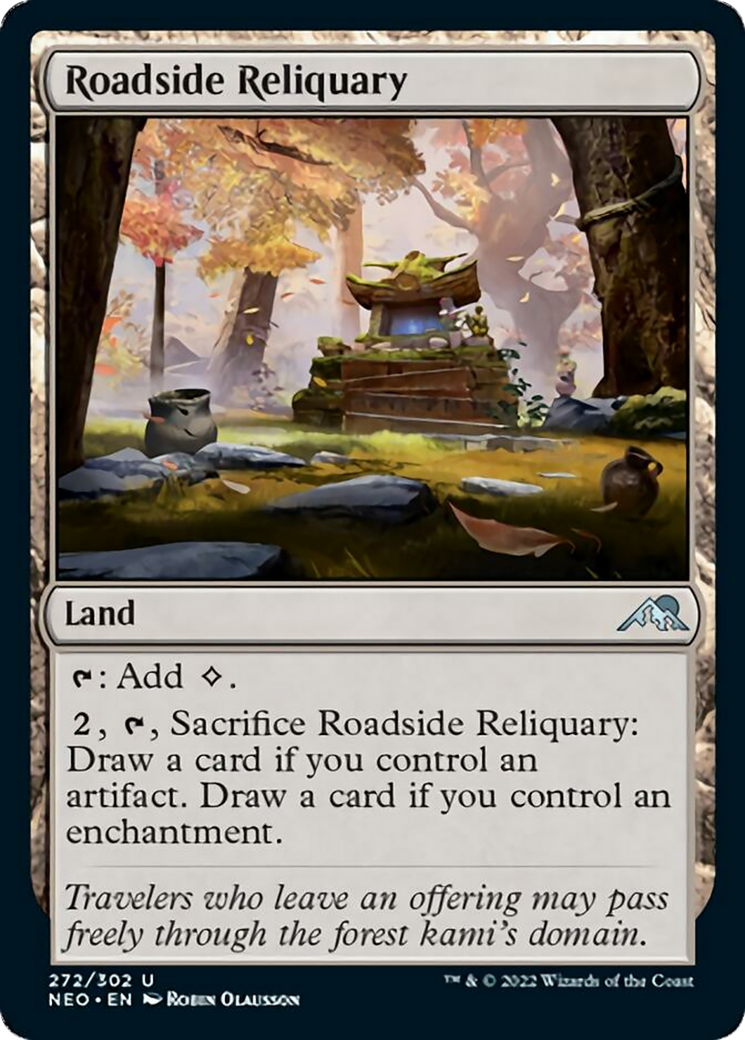
Beyond that this card is potentially a wonderful bit of budget card draw for mono-White EDH decks (which have access to both artifacts and enchantments in abundance), this card drew my attention because it depicts what is probably not a reliquary.
Why not a reliquary? Well, a reliquary is a container for the belongings or the remains of holy persons. In both Christianity and Buddhism, these containers are often small, though in Japanese Buddhism, you do have versions of reliquaries housed in pagodas, like this one at Nara, Japan:
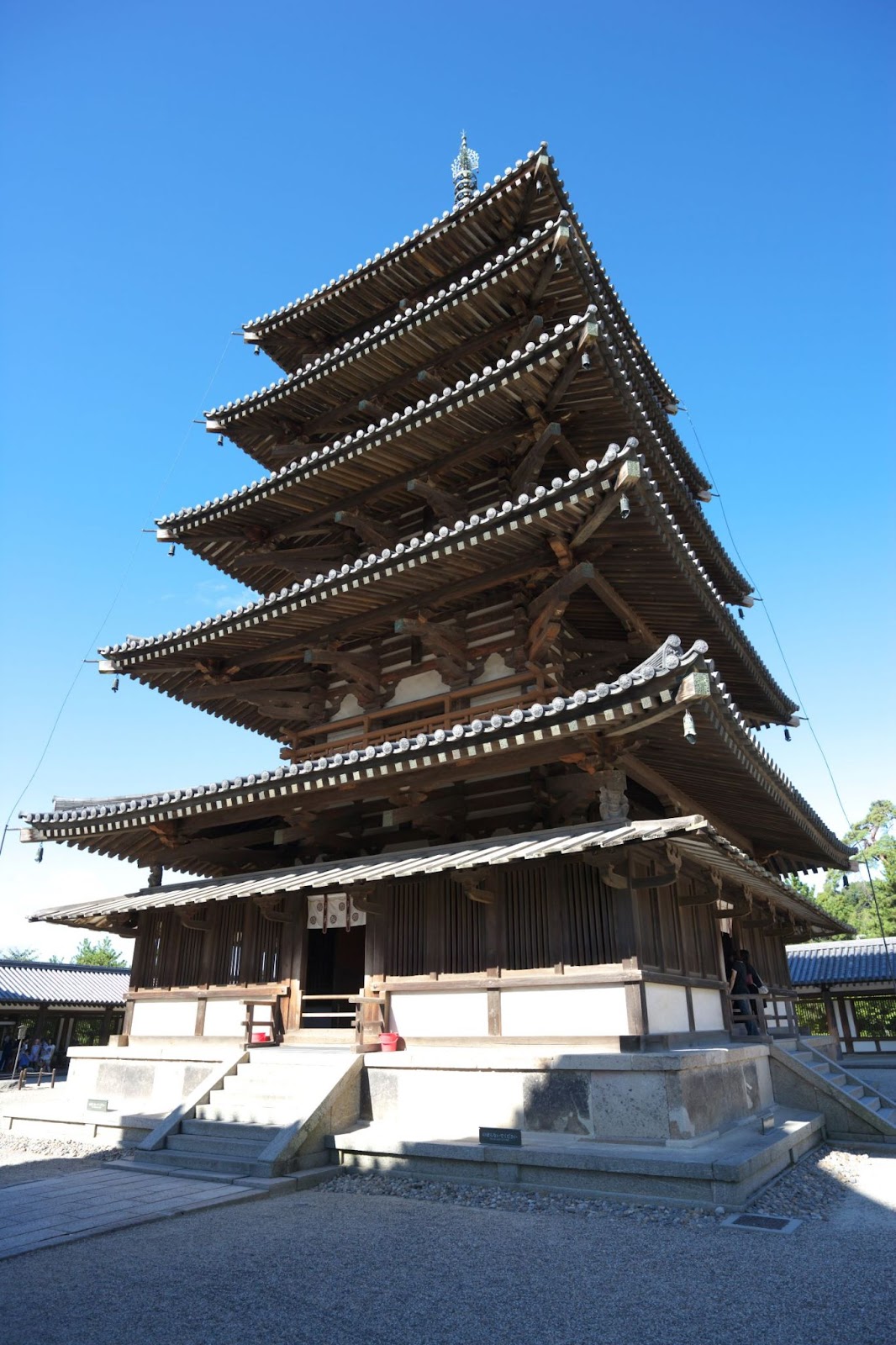
Hōryū-ji temple complex of Nara, home to the Tamamushi Shrine, which contains Buddhist relics at its base.
Because reliquaries and reliquary towers contain sacred objects that are valuable as objects of veneration for religious pilgrims, they are not typically left unguarded in the forest, but are tended to by priests, monks, or other caretakers. We see this model alluded to on Magic’s own Reliquary Tower:
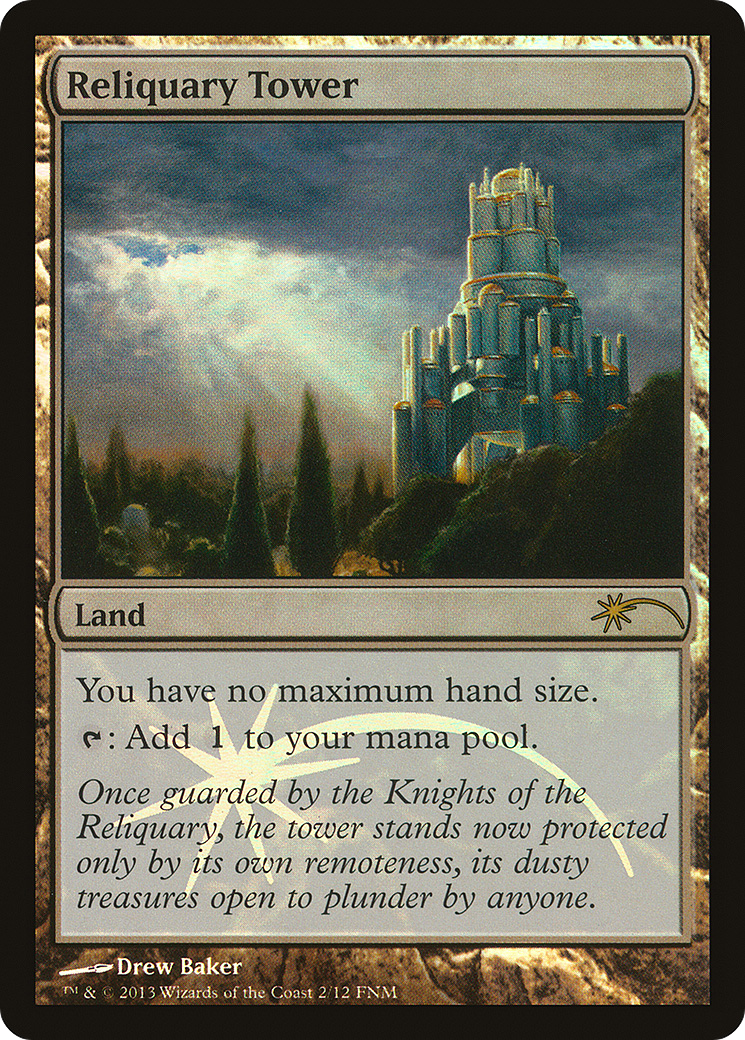
Reliquaries are the kind of objects you keep eyes on and protect; they aren’t generally the kind of thing you leave to the goodwill of a passerby at a roadside. So what is depicted by Roadside Reliquary? Well, it’s likely another kind of wayside shrine, called a hokura (神庫), a small shrine that kami abide in. While a reliquary is a small home for the remains or possessions of dead saints, a hokura is a small home for living kami. The ability of Roadside Reliquary flavorfully depicts this kind of shrine as a place where offerings can be made for safe passage through the kami’s forest.
This confusion of names for sacred spaces isn’t uncommon, however. Keeping the designations of sacred spaces straight can be difficult, sometimes even within one’s own tradition. How many Christians could, without looking it up, articulate the difference between a basilica, a cathedral, a church, an oratory, and a chapel? And, more pertinent to the current set, how many of us know the difference between a temple, a shrine, a torii, a honden, and a go-shintai? I certainly did not, but my curiosity was piqued when I began pondering building a Shrines deck with the new five-color shrines commander, Go-Shintai of Life’s Origin. This article is a glossary of terms for sacred spaces in Japanese religion as they appear in Kamigawa, designed to help folks (like me) who didn’t know a honden from a hokura.
A Brief Note on the Limitations of a Language
When talking about Japanese religious practice—or spiritual practices of fantasy worlds inspired by real-world religions—it’s important to note that English often lacks the nuanced words for sacred spaces that exist in most religions’ culture of origin. Sometimes, we see this manifest in card names as the simple use of a Japanese word, but other times, we see a more generic religious term in English. As regards Japanese religious architecture, the English word “temple” is typically employed to refer to a Buddhist structure, while “shrine” refers to a Shinto structure.
This difference is more about identifying the building’s purpose and its religious affiliation, however, as the architectural styles between the two practices’ buildings are in fact very similar. East Asian religious practices tend to be more syncretic than those of the Abrahamic faiths in general; in Japan, these traditions and their sacred spaces evolved in close conversation with one another for over a thousand years, only to be strictly separated by an 1868 law called the shinbutsu bunri (separation of kami from buddhas). Despite this legal separation, because of this shared history, Shinto shrines and Buddhist temples often utilize the same architectural style, with even similar organizations of sacred space called by different names. On Kamigawa, which has no Buddhist monks nor Shinto priests, the distinction between temples and shrines is at least as muddy. By the time of Kamigawa: Neon Dynasty, the monks of the Order of Jukai have built temples throughout the remains of Jukai forest to make the kami feel welcome. In ancient Kamigawa, the oldest and greatest of these buildings was Okina, Temple to the Grandfathers, depicted here, on Jugan Defends the Temple:
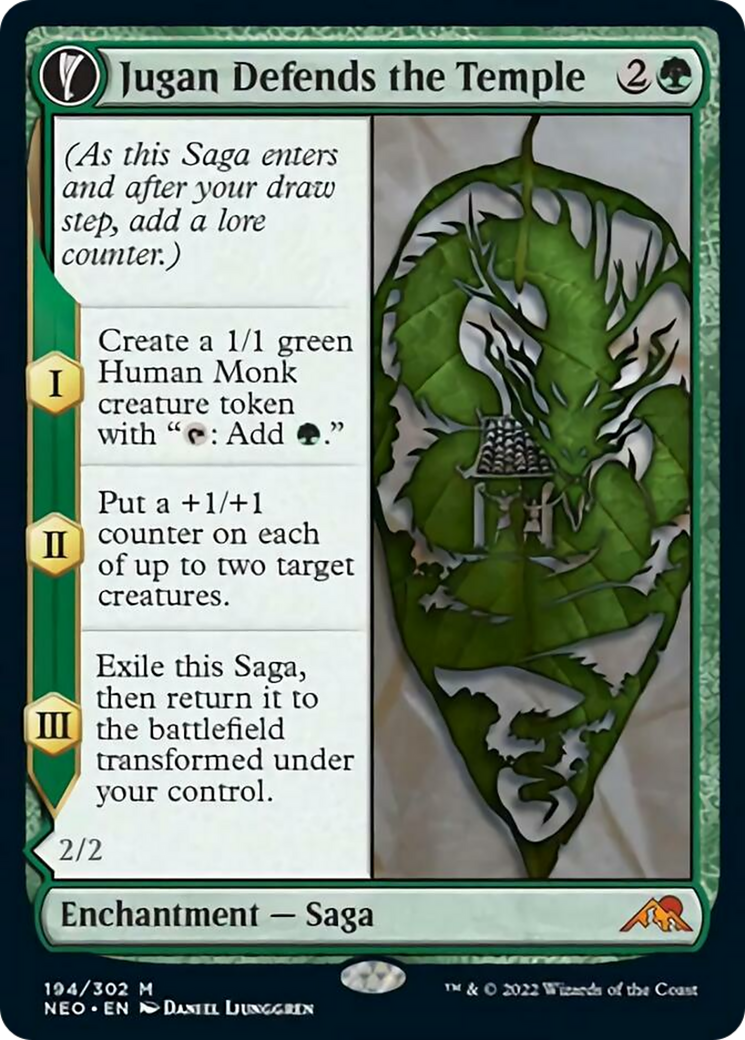
Another way to begin to understand the characteristics of a temple is to look at the etymology of the words we use to name it. In English, “temple” comes from Latin’s “templum,” the origin of which is unclear, but possibly related to being “set apart,” or “cut off” from the mundane. However, in Japanese, Buddhist temples are called Tera (寺), a word which is derived, surprisingly enough, from the Aramaic word for “monastery,” which means “living together.” Thus, the temple is understood as a space “set apart” for a special kind of communal life. In Kamigawa’s Jukai Forest, this communal life among the monks is shared with the forest’s kami, an alliance that is seen especially in the collaborative relationship green enchantment creatures like the have with the forest spirits.
Torii
At the entrance to a temple or shrine complex are the torii, architecturally distinct gates which signal the passage into sacred space. While these gates are also found at Japanese Buddhist temples, they are more commonly associated with and are perhaps the most recognizable symbol of Shinto. In Kamigawa: Neon Dynasty, the symbolic meaning of torii gates, like the kami, are literalized, and the notion of gates as borders between the human and spirit worlds is important to the plot of the interactive novel and a motivation for the presence of Jin-Gitaxias on the plane.
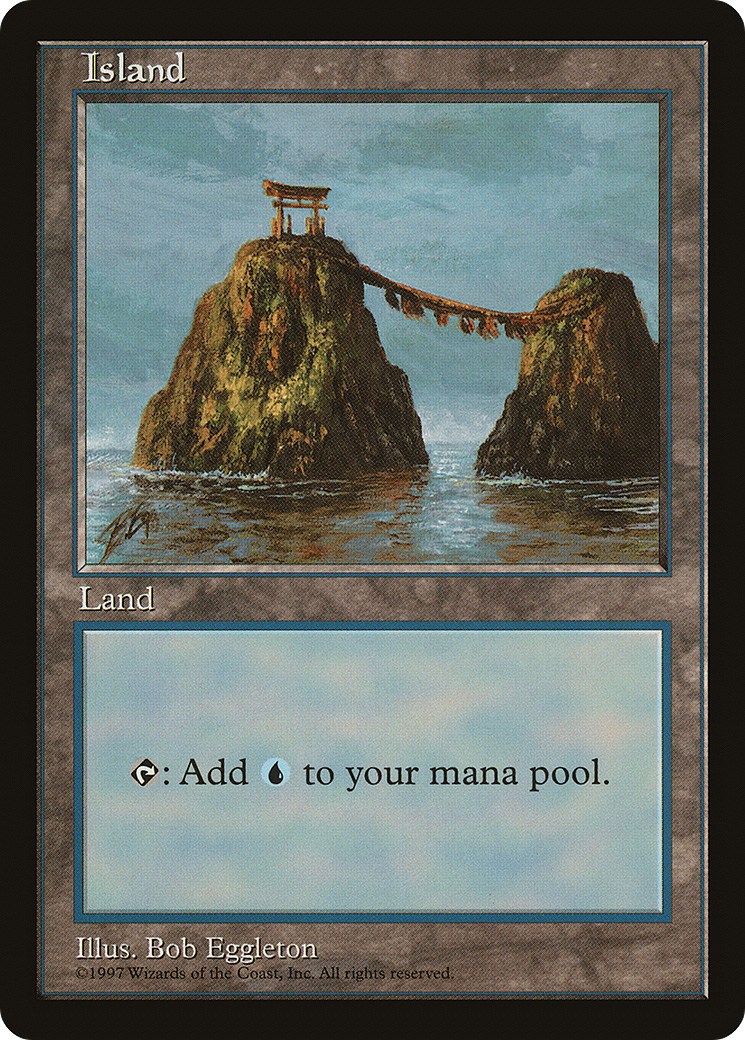
“Island” by Bob Eggleton, depicting Meoto-Iwo, Japan.
Unlike Temples and Shrines, Torii have never been the subjects of their own cards, instead being visible as elements in the environment. In Kamigawa: Neon Dynasty, we see them showing up in the background of over a half-dozen cards, including Piotr Dura’s Mountain (289), Thornwood Falls, Jukai Trainee, and Light the Way. The first torii appeared in Magic art in 1997, on Bob Eggleton’s APAC Island (above). Torii were used extensively on cards in the original Kamigawa block, and in recent years we’ve seen torii show up on cards referencing sanctums—the shrine cycle from Core Set 2021, and Johannes Voss’s Sanctum Prelate—and in the background of Japanese Mystical Archive versions of Faithless Looting and Approach of the Second Sun.
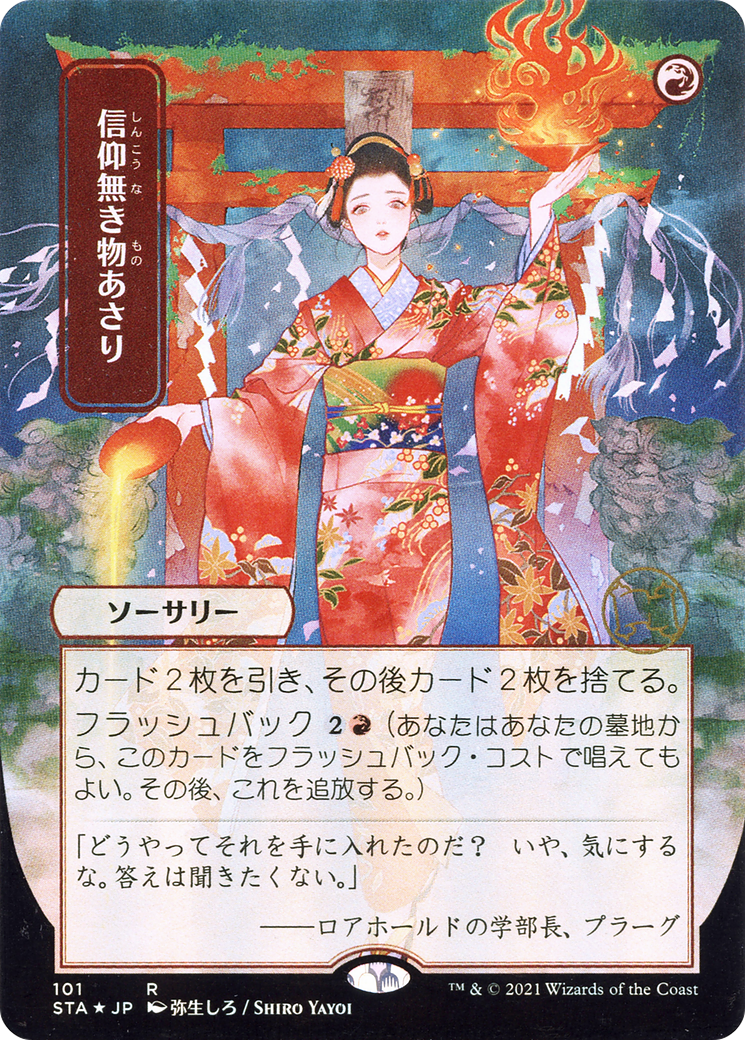
“Faithless Looting” with art by Shiro Yayoi.
Shrines
A shrine is a sacred space, structure, or container meant to be a locus of devotion to a particular holy figure or figures, like heroes, ancestors, spirits, or kami. In some cases a reliquary may even be present as part or the entirety of a shrine, though this is not always the case. When referring to the structures of Shinto, however, the English word “shrine” designates a structure or collection of structures meant to serve as a home for the kami. Their role as homes for kami and the kami’s go-shintai are indeed what make them shrines. In Japanese, the word used is often jinja (神社), literally, “place of the gods,” though a number of other words, each communicating specific traits of a sacred space, are also used.
In Magic, the word “Shrine” has appeared as a noun on a number of artifacts, enchantments, and lands, but the “shrine” subtype has only appeared on legendary enchantments, all of which—even those printed in Core Set 2021—depict locations on Kamigawa.
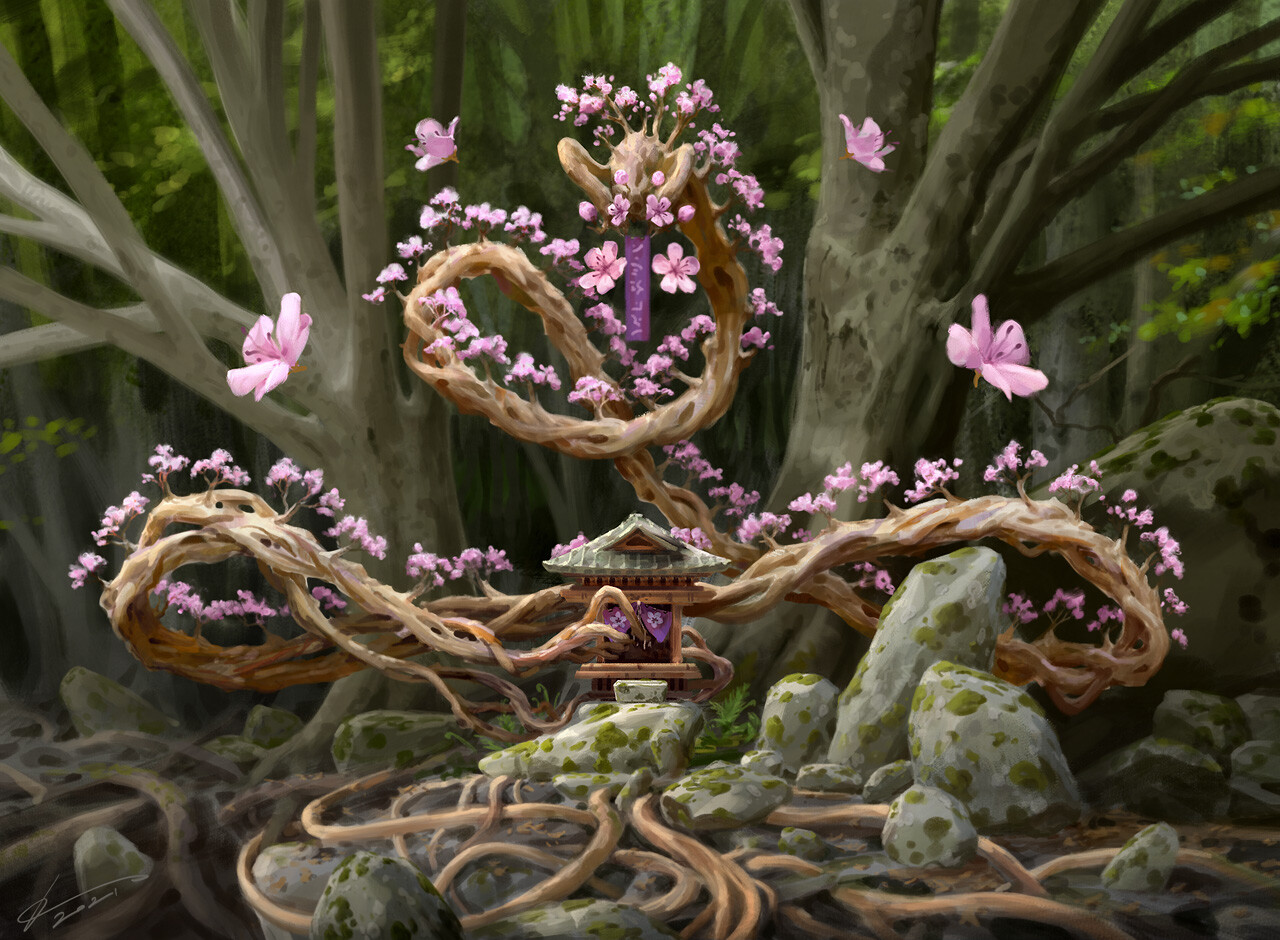
“Go-Shintai of Boundless Vigor” by Johannes Voss
Go-Shintai
A shrine in the Shinto tradition is so-called because it “enshrines” something, and this something is the go-shintai (or sometimes simply “shintai”). Go-shintai are the “bodies of the kami,” the physical objects to which a kami is drawn and in which it resides. These “bodies” are not parts of the kami themselves, but merely the way the kami are made accessible in the material world—points where humans can connect with the divine.
Most go-shintai are works of artifice: mirrors, swords, jewels, statues, and so on (in which kami are invited to live), but some are awe-inspiring natural features, like massive trees, or sacred mountains, in which kami have already taken up residence. Mt. Fuji is an example of a real life shintai, and if one sees an isolated torii, it is likely pointing toward the presence of this naturally occurring sacred space.
Magic’s six Go-Shintai depict the “living” aspect of the kami’s presence as animating artificial shintai. Each small shrine on these legendary enchantment creatures appears alive with a supernatural presence as the world around the shrine is transformed by the powerful spirit that abides there. Strangely, in all but one case, the stories of Magic’s Go-Shintai depict the kami as being attracted not to the shrine that would house the shintai, but to the shrine itself as the shintai.
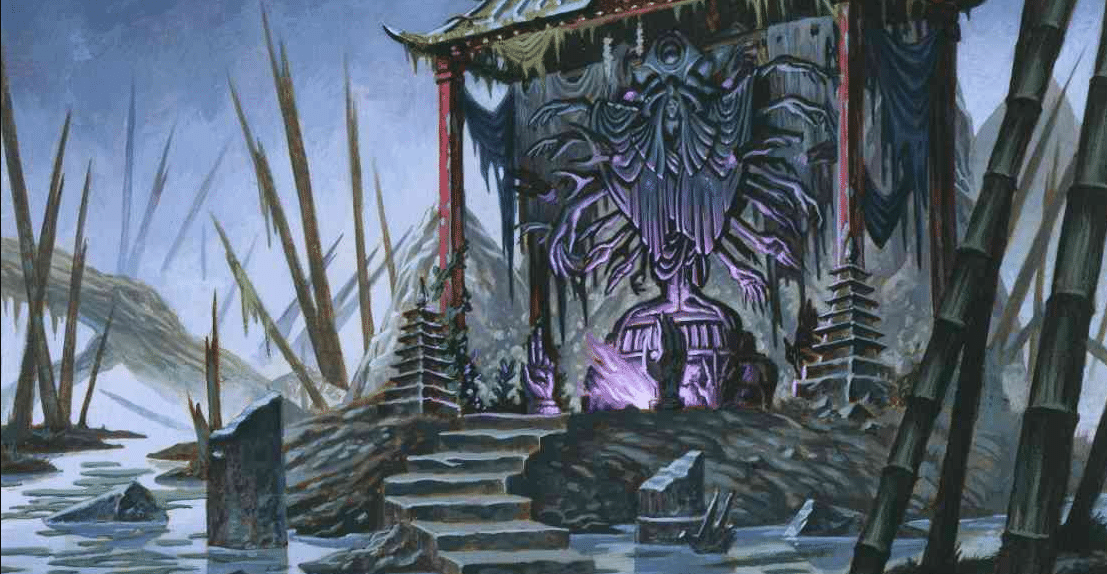
“Honden of Night’s Reach” by Jim Nelson
Honden
In the case of artificial shintai, like the ones depicted on Kamigawa Neon Dynasty’s Go-Shintai, large shrines often erect a special building to house them. That building is called a honden, and it is solely for the protection of the shintai and as a house for the resident kami. Like the go-shintai, Kamigawa’s honden are depicted without clear visual reference to the shrine complexes that would normally surround them, and most of them don’t even clearly depict a honden, but an element of the honden that symbolizes the kami—a statue, for example, on Honden of Cleansing Fire. In the original Kamigawa block, this absence communicates the alienation between the kami and the mortals that had perhaps once tended the surrounding grounds—all that remain are the decrepit pieces of the kami’s derelict abode.
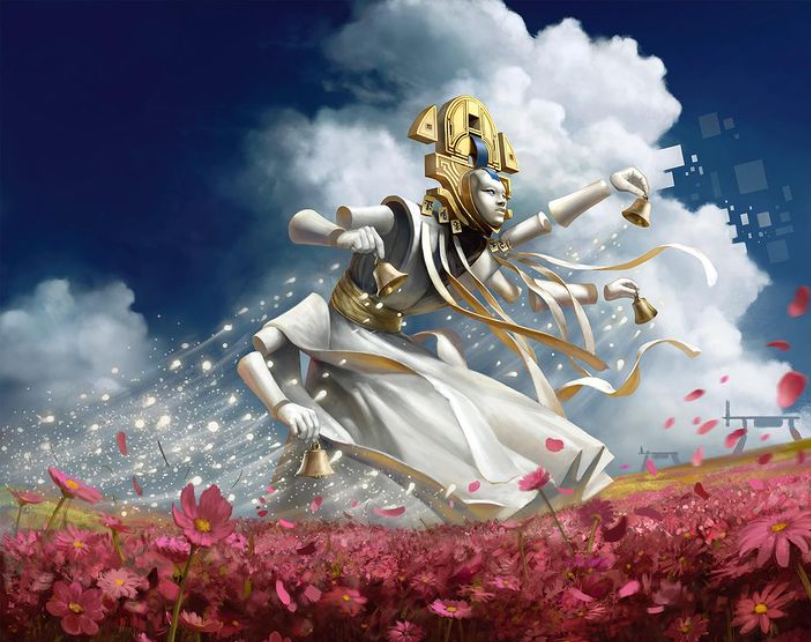
“Myojin of Blooming Dawn” by Yigit Koroglu
Myojin
Myojin is a term that refers to a kami of special importance or power, and sometimes also the name given to such a powerful kami’s shrine. The five honden of the original Kamigawa block each enshrined a myojin’s shintai, but the myojin of Kamigawa: Neon Dynasty don’t seem to abide in shrines, instead roaming the world.
Komainu
Depicted on Komainu Battle Armor and Reito Sentinel, komainu are the stone “lion dogs” that guard the entrance to a shrine’s honden. In real-world shrines of Inari, these are replaced by foxes, and occasionally other variations are seen across China and Okinawa, as well, on rooftops and at the entrance to other important buildings.
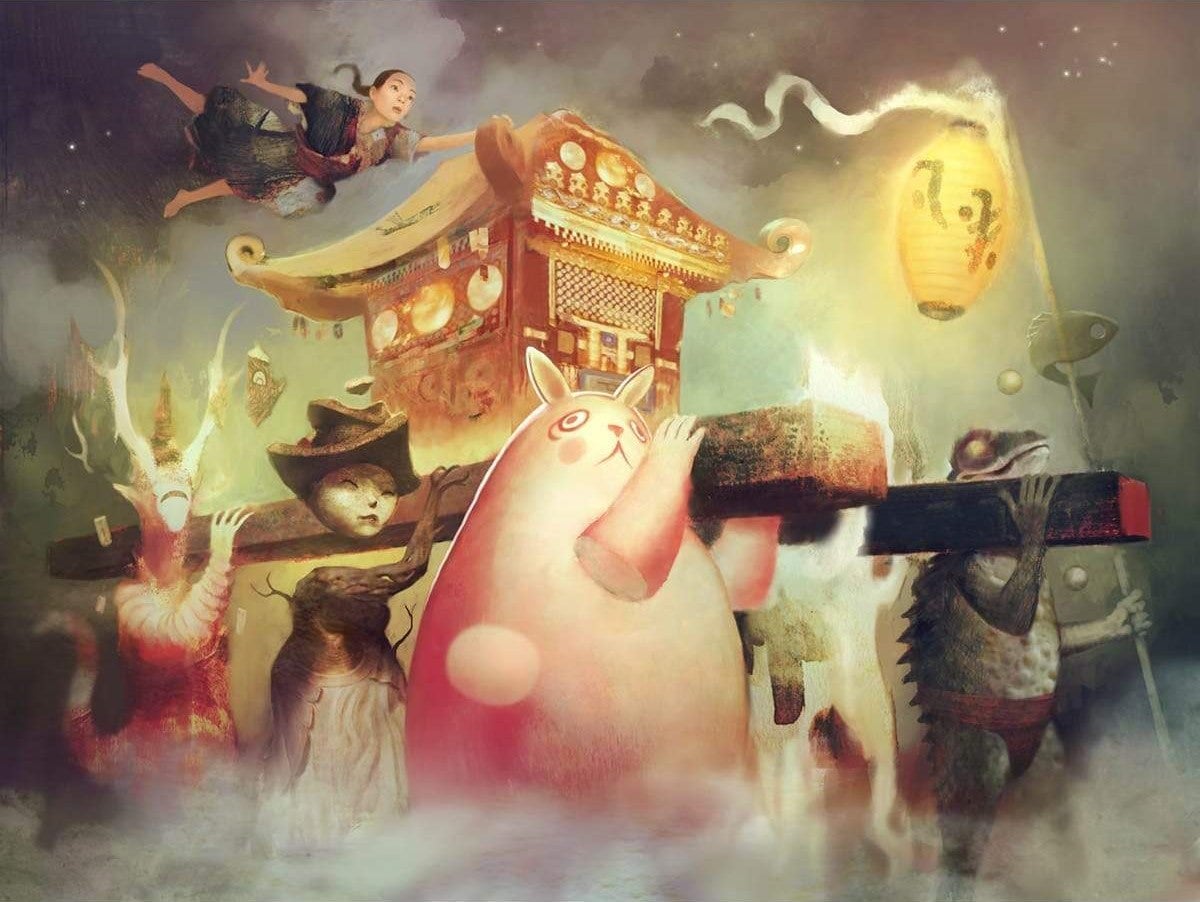
“March of Otherwordly Light” by Nils Hamm
Mikoshi
Mikoshi is not a word used on a Magic card, but the object is nevertheless depicted several times! Artificial shintai are sometimes removed from their honden during festivals (祭, matsuri) for veneration by the faithful. At these times of religious celebration, the shintai are placed into little portable shrines called mikoshi (神輿), which are depicted on Kamigawa: Neon Dynasty’s “March” cycle.
During a festival, these portable shrines containing the shintai and their kami are sometimes paraded through the streets. Kamigawa: Neon Dynasty portrays an interesting twist on this tradition, emphasizing the greater role that kami play in everyday society. Instead of being carried by shrine priests, the mikoshi (and ostensibly a more important kami?) is being held aloft by other kami themselves!
Some Concluding Remarks
In researching shrines and sacred architecture, one of the things I’ve continually stumbled over is that in Magic, shrine-related words with particular meanings in Japanese religious traditions are often used loosely, sometimes synonymously, for their flavor rather than their accuracy. A hokura is not a reliquary, but “Roadside Reliquary” rolls off the tongue. None of the Go-Shintai actually depict shintai, technically speaking, but rather seem to depict physical manifestations of kami pouring out of the shrines that would normally house (rather than be) the go-shintai itself. A shintai is not a shrine, and a honden may or may not be a part of a shrine, but isn’t the shrine itself. You get the idea.
Were Kamigawa to hew closer to real world Shinto understandings, we might see Go-Shintai showing up as “Enchantment Lands,” like Urza’s Saga—landforms, like Mt. Fuji, where kami certainly abide. We could also see shintai worked by human hands, things like swords and statues, represented by “Enchantment Artifacts” like Theros’s Spear of Heliod, where the presence of the divine is channeled through the kami’s attraction to a desirable object (a yorishiri).
But despite the original Kamigawa using the phrase “Shinto gone wrong” to describe the aesthetic and folkloric background of the world, we need not expect it to follow all the expected rules (just like the 16th century Catholics of the Orzhov Syndicate and Ixalan did not). Instead, Kamigawa: Neon Dynasty imagines a world that is more harmonious, where the spirits that elude our frail senses in the day-to-day are more numerous than we ever imagined, and where the spiritual world doesn’t abide by the formal religious expectations we have of it. Sometimes a go-shintai can simply be a place for a kami to hang their hat.
…but Roadside Reliquary is probably not a reliquary.
Recommended Resources
“Honden and Myojin” by Wizards of the Coast
“A Kamigawa Glossary,” by Wizards of the Cast (Part One, Part Two, Part Three)
“The Legends of Kamigawa: Neon Dynasty” by Ari Zirulnik, Grace Fong, Emily Teng, and Gerritt Turner

